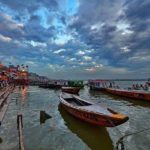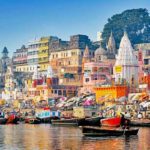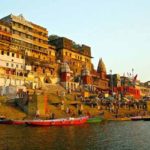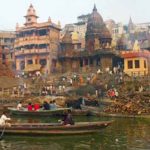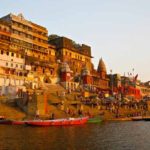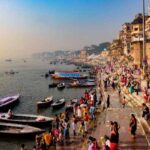A Complete Guide for Varanasi, also known as Kashi, is one of the oldest and holiest cities in India, nestled along the banks of the sacred Ganges River. Steeped in history, spirituality, and cultural richness, Varanasi is a city that enthralls visitors with its mystique.
The city is renowned for its ghats, long stone steps leading to the Ganges, where pilgrims and devotees come to perform sacred rituals and ceremonies. Dashashwamedh Ghat, the most prominent, hosts a mesmerizing Ganga Aarti, a captivating ritual of light and devotion, every evening.
Varanasi is a tapestry of temples, each with its unique architectural beauty and spiritual significance. The Kashi Vishwanath Temple, dedicated to Lord Shiva, stands as a testament to the city’s profound religious heritage.
The narrow, winding streets of Varanasi’s old town offer a glimpse into the city’s ancient soul. Here, vibrant markets overflow with textiles, silk fabrics, handicrafts, and a wealth of local delicacies. The famed Banarasi sarees, renowned for their intricate craftsmanship, are a cherished souvenir for visitors.
The Banaras Hindu University, one of Asia’s largest residential universities, is another jewel in the city’s crown. Its sprawling campus, with an art museum and lush gardens, adds a touch of academic vitality to Varanasi Tour Packages.
Varanasi is a place of spiritual introspection and enlightenment, drawing seekers from all corners of the globe. The tranquil ambiance along the riverbanks provides a serene backdrop for meditation, yoga, and self-discovery.
In Varanasi, life and death coalesce in a unique, deeply spiritual way. The city’s burning ghats, notably Manikarnika and Harishchandra, where funeral pyres burn ceaselessly, offer a poignant reminder of the impermanence of life.
Varanasi Tourism, with its indelible spiritual aura, historical treasures, and cultural vibrancy, is a city that resonates with the soul of India, leaving an indelible mark on every traveler fortunate enough to experience its magic.
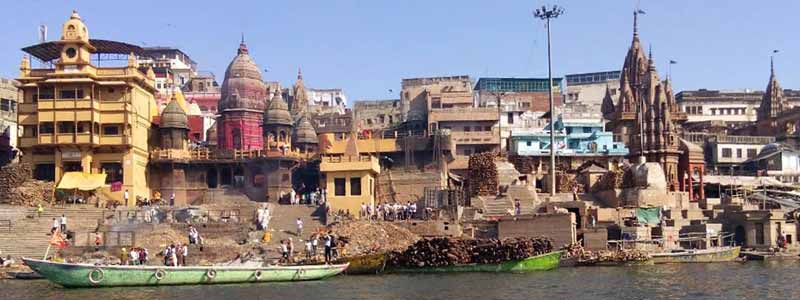
History of Varanasi (Kashi)
Varanasi, often referred to as Kashi, is one of the oldest continuously inhabited cities in the world. Its history stretches back over 3,000 years, making it a living testament to India’s ancient cultural and spiritual heritage.
According to Hindu mythology, Varanasi was founded by Lord Shiva, making it an important pilgrimage site for Hindus. It is believed to be the place where the trident of Lord Shiva first emerged from the cosmic waters. Over the centuries, it became a center of learning, spirituality, and cultural exchange.
In the 6th century BCE, under the patronage of Emperor Ashoka, Varanasi saw significant growth and development. Ashoka erected grand stupas and monasteries, fostering a vibrant Buddhist community. The city played a crucial role in the spread of Buddhism across Asia.
During the Gupta Empire (4th to 6th centuries CE), Varanasi emerged as a major cultural and religious center. It was a hub for scholars, poets, and philosophers, including the famous poet-saint Tulsidas, who composed the epic Ramcharitmanas here.
Over the centuries, Varanasi witnessed the rise and fall of various empires, including the Mughals and the Marathas. The city’s cultural richness continued to flourish, with the construction of numerous temples, ghats, and palaces Varanasi Private Day Tours.
In the 18th century, Varanasi came under British control, becoming an important administrative center in the region. The British influence led to the establishment of educational institutions, including the renowned Banaras Hindu University in 1916.
Today, Varanasi stands as a living museum of India’s diverse history and religious traditions. Its ancient temples, bustling markets, and vibrant ghats continue to attract pilgrims, scholars, and travelers from around the world. The Ganges River, which flows through the heart of the city, remains central to the spiritual life of Varanasi, offering a place for purification, prayer, and reflection.
Varanasi’s enduring legacy as a center of spirituality, culture, and learning makes it a city of immense significance in the tapestry of Indian history.
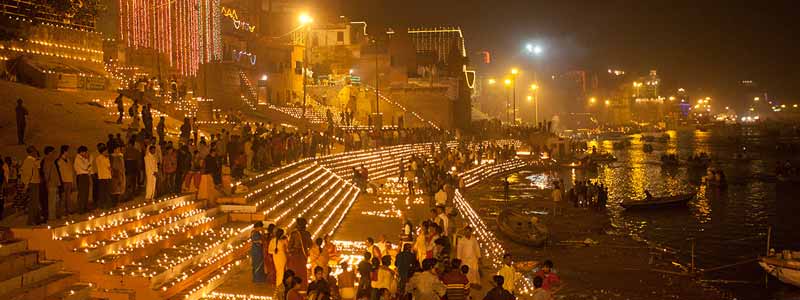
Places to visit Varanasi
Varanasi, one of the oldest and holiest cities in the world, offers a wealth of spiritual, cultural, and historical experiences. Here are some must-visit places in Varanasi:
Kashi Vishwanath Temple: This ancient and revered Hindu temple is dedicated to Lord Shiva. It is considered one of the most important pilgrimage sites for Hindus.
Dashashwamedh Ghat: One of the oldest and most vibrant ghats in Varanasi, it is famous for the mesmerizing Ganga Aarti held every evening.
Assi Ghat: Located at the confluence of the Ganges and Assi rivers, this ghat is popular for its serene atmosphere and is believed to be the place where Lord Shiva once lived.
Sarnath: A short distance from Varanasi, Sarnath is where Lord Buddha delivered his first sermon after attaining enlightenment. It houses several ancient Buddhist structures, including the Dhamek Stupa.
Manikarnika Ghat: One of the two main cremation ghats in Varanasi, this site is of great spiritual significance for Hindus, as it is believed that cremation here leads to moksha (liberation from the cycle of rebirth).
Bharat Mata Temple: This unique temple is dedicated to Mother India and features a relief map of India carved out of marble.
Banaras Hindu University (BHU): One of the largest residential universities in Asia, BHU is not only an educational institution but also a beautiful campus with lush gardens and impressive architecture.
Ramnagar Fort and Museum: Located on the eastern bank of the Ganges, this fort is the ancestral home of the Maharaja of Varanasi and houses a museum showcasing vintage cars, weaponry, and artifacts.
Tulsi Manas Temple: This modern temple is dedicated to Lord Rama and is believed to be located at the spot where Tulsidas, the great Hindu poet, wrote the Ramcharitmanas.
Durga Temple (Monkey Temple): This temple is dedicated to Goddess Durga and is renowned for its vibrant red color and the numerous monkeys that inhabit the vicinity.
Chunar Fort: Located about 40 kilometers from Varanasi, this ancient fort offers a glimpse into the region’s historical significance and provides panoramic views of the Ganges.
These are just a few of the many fascinating places to explore in Varanasi. Each site carries its own unique cultural, historical, and spiritual significance, contributing to the city’s rich tapestry of heritage and tradition.

Visit the Ghats of Varanasi
Visiting the ghats of Varanasi is a unique and essential experience for anyone exploring this ancient city. The ghats, stone steps leading to the Ganges River, are not just physical structures; they are the spiritual and cultural heart of Varanasi. Here’s how you can make the most of your visit to the ghats:
Dashashwamedh Ghat: Start your exploration with Dashashwamedh Ghat. This ghat is famous for the Ganga Aarti that takes place every evening. It’s a mesmerizing and spiritually charged experience.
Assi Ghat: Assi Ghat is known for its peaceful and artistic vibe. It’s a great place to sit by the river, meditate, or enjoy a boat ride. It’s also the southernmost ghat in Varanasi.
Manikarnika Ghat: Manikarnika is one of the two cremation ghats in Varanasi. While it might sound morbid, it’s a place of deep spiritual significance. Witnessing the cremation ceremonies can be a humbling experience.
Harishchandra Ghat: This is the second cremation ghat and is located a little downstream from Manikarnika. Both ghats are associated with the eternal cycle of life and death, central to Hindu beliefs.
Visiting the ghats of Varanasi is a sensory and spiritual journey, allowing you to immerse yourself in the city’s rich cultural and religious traditions. It’s an experience that will stay with you long after you leave this ancient and sacred city.
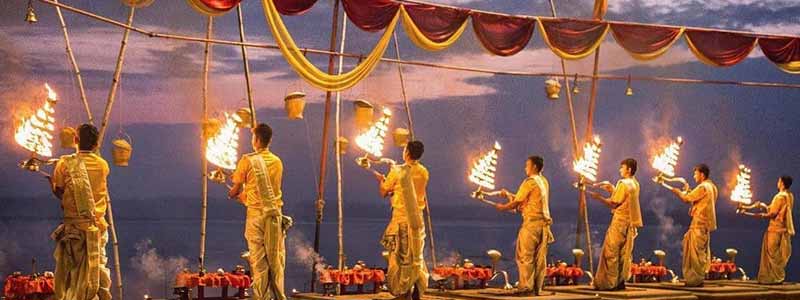
Best Places to eat in Varanasi
Varanasi offers a wide range of culinary experiences, from traditional Indian dishes to international cuisine. Here are some of the best places to eat in Varanasi:
Bana Lassi: Known for its creamy and delicious lassis, this small shop is a favorite among both locals and tourists. They offer a variety of flavors, and it’s a great spot for a refreshing drink.
Blue Lassi Shop: Another popular lassi shop in Varanasi, Blue Lassi offers a wide range of lassi flavors, including sweet and savory options. It’s an iconic place for a lassi tasting experience.
Kachori Gali: This street is famous for its kachoris, a popular North Indian snack. You can find a variety of kachori stalls serving mouthwatering treats.
Deena Chaat Bhandar: Located near Dashashwamedh Ghat, this place is renowned for its chaat, a flavorful and spicy Indian street food. Try their aloo tikki chaat and other savory snacks.
Pizzeria Vaatika Café: If you’re in the mood for pizza, this Italian restaurant in the heart of Varanasi offers a great selection of wood-fired pizzas and pasta dishes.
Brown Bread Bakery: A popular spot for travelers, this bakery and cafe serves a variety of international dishes, including breakfast items, sandwiches, and cakes. They also have a great view of the Ganges.
Kashi Chat Bhandar: Located in the Godowlia area, Kashi Chat Bhandar is known for its variety of chaats, especially the famous tamatar (tomato) chaat and other spicy treats.
Varanasi’s culinary scene is diverse, with something to satisfy every palate. Whether you’re looking for traditional Indian street food, international cuisine, or fusion dishes, Varanasi has a variety of dining options to explore.
Best Time to visit Varanasi
The best time to visit Varanasi, one of India’s oldest and most culturally rich cities, largely depends on your preferences and the kind of experience you seek. However, there are two primary seasons to consider:
Winter (October to February): This is the most popular time to visit Varanasi. The weather is cool and comfortable, with temperatures ranging from 5°C (41°F) to 20°C (68°F). The Ganges River is calm, and outdoor activities are pleasant. The city hosts many festivals during this time, including Diwali, Dev Deepawali, and Christmas. The clear skies and pleasant temperatures make it an excellent time for sightseeing, boat rides, and exploring the ghats.
Summer (March to June): Summers in Varanasi can be scorching, with temperatures often exceeding 40°C (104°F). It’s not the most comfortable time for tourists, but if you can handle the heat, you’ll find fewer crowds and better deals on accommodations. Remember to stay well-hydrated and protect yourself from the sun.
Monsoon (July to September): The monsoon season brings relief from the heat but also heavy rains and humidity. While the city takes on a lush, green appearance, the Ganges can become turbulent and not suitable for boat rides. You can still visit during this time, but be prepared for wet conditions.
In conclusion, the best time to visit Varanasi for most travelers is during the winter months (October to February). The cool and pleasant weather, along with the festive atmosphere, allows you to explore the city and its spiritual and cultural heritage comfortably. However, if you prefer quieter and budget-friendly travel, consider visiting during the shoulder seasons or even the early part of the monsoon season. Regardless of when you visit, Varanasi promises an authentic and spiritually rich experience that’s unlike any other place in India.
How to Reach Varanasi
Varanasi, located in the northern state of Uttar Pradesh, is well-connected by various modes of transportation. Here’s how you can reach Varanasi:
By Air: Varanasi has its own airport, Lal Bahadur Shastri International Airport (VNS), which is well-connected to major Indian cities. Several domestic airlines operate regular flights to and from Varanasi. From the airport, it’s about a 30-minute drive to the city center.
By Train: Varanasi Junction (BSB) is one of the busiest railway stations in North India. It is well-connected to major cities across the country. Trains from Delhi, Mumbai, Kolkata, and other major cities have regular services to Varanasi. The station is located in the heart of the city, making it convenient for travelers.
By Road: Varanasi is well-connected by road to nearby cities and states. National Highways (NH2 and NH7) pass through Varanasi, making it accessible by road from places like Delhi, Agra, Kolkata, and Lucknow. Several state and private buses operate on these routes. You can also opt for a private taxi or drive your own vehicle.
By Waterways: Varanasi is located on the banks of the River Ganges, and river travel is an option, particularly for tourists arriving from nearby cities like Allahabad. There are regular boat services from places like Allahabad, but this mode of transportation is not as commonly used as air, train, or road travel.
Local Transportation: Once you reach Varanasi, you can use a variety of local transportation options. Cycle rickshaws and auto-rickshaws are popular for short distances within the city. Taxis and e-rickshaws are also available. For a unique experience, consider hiring a boat for a ride along the Ganges.
Varanasi is a popular destination, and transportation options are well-developed to cater to travelers’ needs. Depending on your location and preferences, you can choose the mode of transport that best suits your itinerary and budget.


